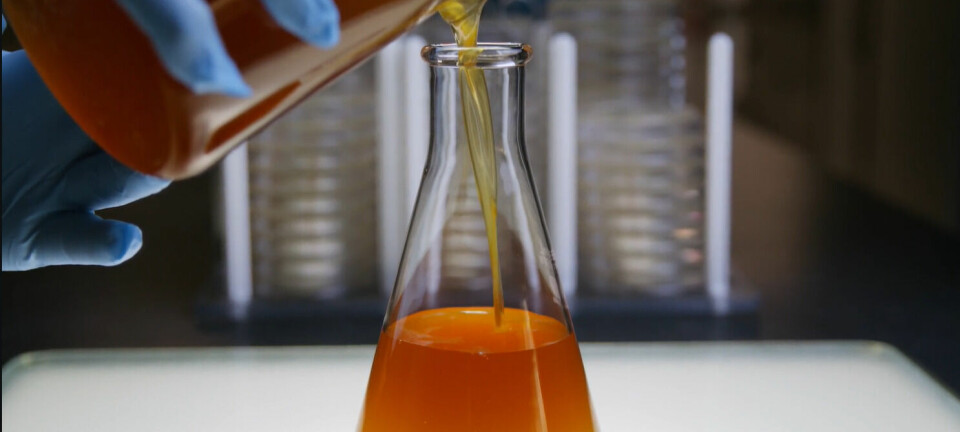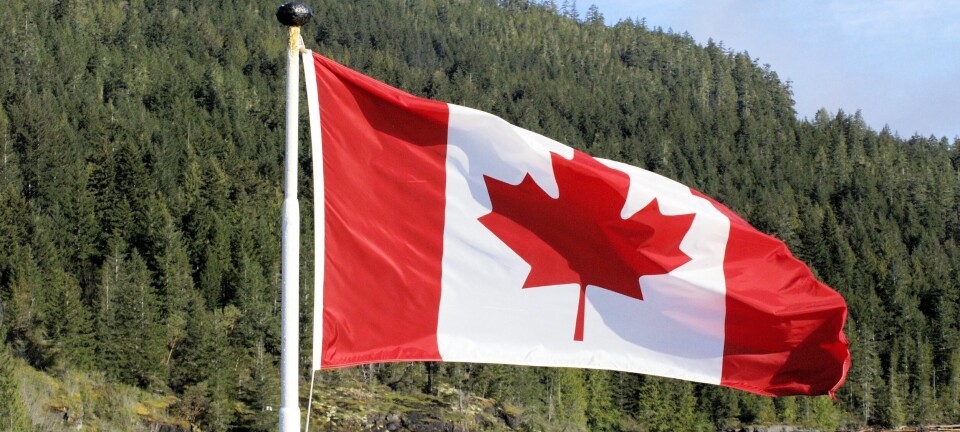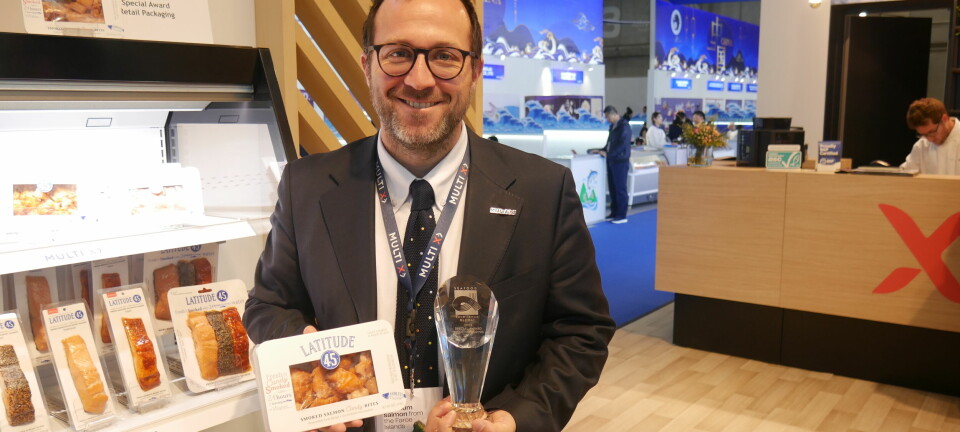US consumers buy 40 million more pounds of farmed Atlantic salmon despite a price increase of 30-40%
Odd Grydeland odd@fishfarmingxpert.com
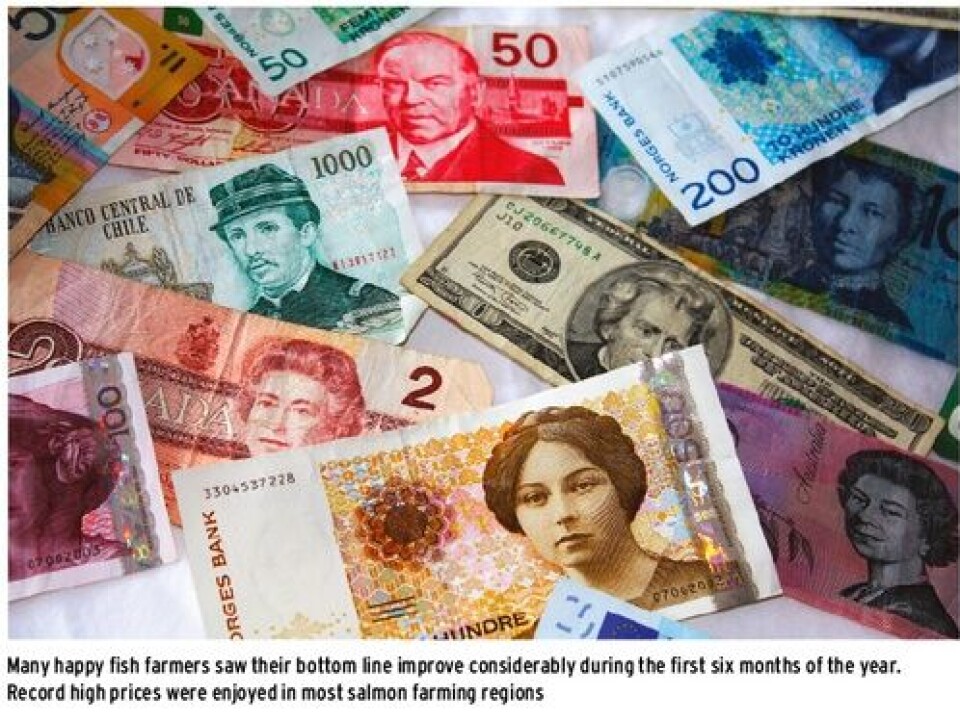
There were a lot of smiling faces to be seen at the AquaNor trade show in Trondheim this year. 2013 has been good for most producers of Atlantic salmon, with record prices obtained in most of the major markets. In the U.S., wholesale prices for Atlantic salmon fillets from Chile delivered Miami and whole, dressed fish sold in Seattle were US$ 5.15 and 3.44 per pound (~€ 8.64 & 5.78- NOK 69.30 & 46.30 per kilo), respectively during the second quarter of 2013. These prices were 43 per cent higher compared with the same quarter last year, and 25% and 28% higher than those achieved during the first quarter of 2013.
The results (Operational EBIT) during the first six months of 2013 for the Canadian operations of the Norwegian fish farming companies were as follows, before adjustments for fair value; All companies also registered a positive adjustment for fair value of fish biomass, adding to the financial bottom line.

One of the obvious reasons for the strong performance of these companies is the relatively slow growth of supply compared with the world-wide increase in demand for high quality, fresh Atlantic salmon. The Norwegian company Kontali estimates that the production in 2013 will only increase by about two per cent this year compared with 2012, which saw a ~22% increase over the 2011 production output. Norway’s production will be down by about four per cent this year- to some 1,138 thousand tonnes. This is still over ten times the production of Atlantic salmon from Canada, which will drop by an estimated 14 per cent this year compared with 2012- to about 107 thousand tonnes. One of the reasons for this is the government-authorized destruction of salmon from farms diagnosed as positive for different fish viruses- ISAV on Canada’s east coast and IHNV in British Columbia. In B.C., Marine Harvest expects to harvest about 33,000 tonnes, down 18% from last year and for Mainstream, its production is expected to amount to only 15,000 tonnes, down from 19,000 tonnes in 2012. Grieg Seafood plans to harvest a mere 8,000 tonnes in B.C. this year- down by 41% from 2012 due to problems with smolt supply from its hatchery. Thus, the farmed salmon production from the west coast of Canada will be close to only half of its former all-time high. On the bright side, prices are expected to remain high for the foreseeable future, and companies in B.C. expect to be back to “normal” production by sometimes in 2015.
Marine Harvest Canada It is said that “hindsight is 20/20”, and if the British Columbia-based staff at Marine Harvest had the opportunity, they would likely not have decided to reduce the smolt stocking “by up to 30% for both 2012 and 2013” as was announced in late 2011. Globally, Marine Harvest expects to harvest some 57,000 tonnes or 14% less Atlantic salmon this year compared with 2012. But the company is now investing about NOK 1.2 billion (~€150 million) in additional working capital in order to increase production in 2014 by some 55,000 tonnes- to a world-wide harvest of about 390,000 tonnes. The company had a record EBIT of NOK 901 million (~€112.3 million) during the second quarter of 2013- more than 140% of the total EBIT of NOK 643 million (~€80.15 million) for all of 2012. In Canada, the second quarter of 2013 saw the harvesting by Marine Harvest of 8,932 tonnes of Atlantic salmon- a drop of 1,645 tonnes from the same period in 2012, but the Operational EBIT was NOK 174 million (€21.7 million) higher. The company attributes the improvement in its quarterly results to a combination of favourable prices and costs, reduced claims ratio and the spot position of sales. With very few long-term sales contracts, Marine Harvest Canada was able to take advantage of the steady increases seen in the U.S. spot market for fresh Atlantic salmon. The company has also seen a gradual drop in discards and claims due to the Kudoa parasite- the cost of which dropped from NOK 6.1 million (~€760,000) during the first quarter of 2013 to a total of NOK 4.4 million (~€550,000) in the second quarter of this year.
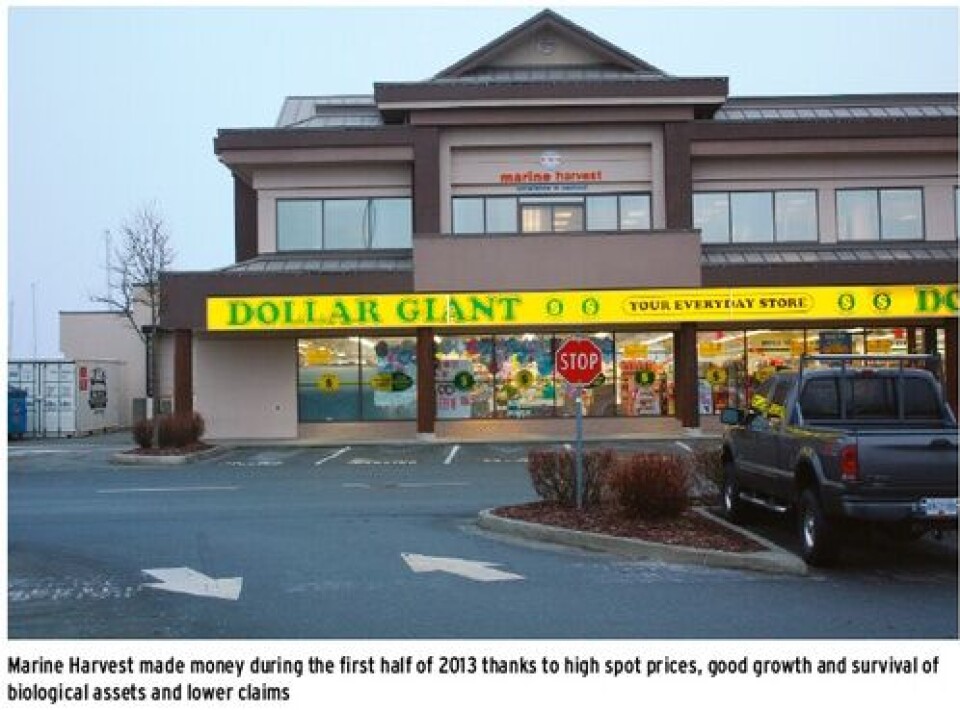
While favourable development in the biological performance (growth and survival) has contributed to cost reductions in Canada, Marine Harvest states that the previously planned reduction in harvest volume will continue to negatively influence the full cost per kilo going forward. No significant mortality was recorded due to seasonal algae blooms during the first half of 2013, despite the occurrence of some blooms in July and August. In its Q2 2013 report, the Marine Harvest Board of Directors says that “it is impressed with the Canadian results in the second quarter and appreciates the efforts put in to turn the operations around”.
Marine Harvest was an active participant in the Salmon Aquaculture Dialogue facilitated by the World Wildlife Fund, which culminated with the development of a certifiable standard for sustainable salmon farming (ASC Salmon Standard) that was launched in April during the European Seafood Exhibition. While some companies- Marine Harvest Canada being among them- have pursued certification under the Best Aquaculture Practices (BAP) program established by the standard-setting Global Aquaculture Alliance (GAA), the head office of Marine Harvest in Norway states in its quarterly report that it has an ambition to have 100% of its farms certified by the ASC Salmon Standard by 2020. “The ASC Salmon Standard sets an unprecedented standard for sustainable seafood production”, states the company. Marine Harvest Canada announced in July this year that it was the first farm-raised salmon producer in British Columbia to achieve three-star BAP-certification under the GAA program that includes its farms, its feed producer (Skretting North America) and its fish processing plant in Port Hardy on Vancouver Island. Marine Harvest Canada owns about 55% (75) of the 136 farm sites approved for the production of salmon in B.C.
Marine Harvest reports an average achieved spot price of NOK 41.65 (~€5.19, US$6.82) per kilo during the third quarter of 2013 (to August 21), and the company’s Board “is encouraged by the continuing high spot prices, combined with futures prices of NOK 34 (~€5.82) per kg for the fourth quarter and NOK 35 per kg for the year 2014”.
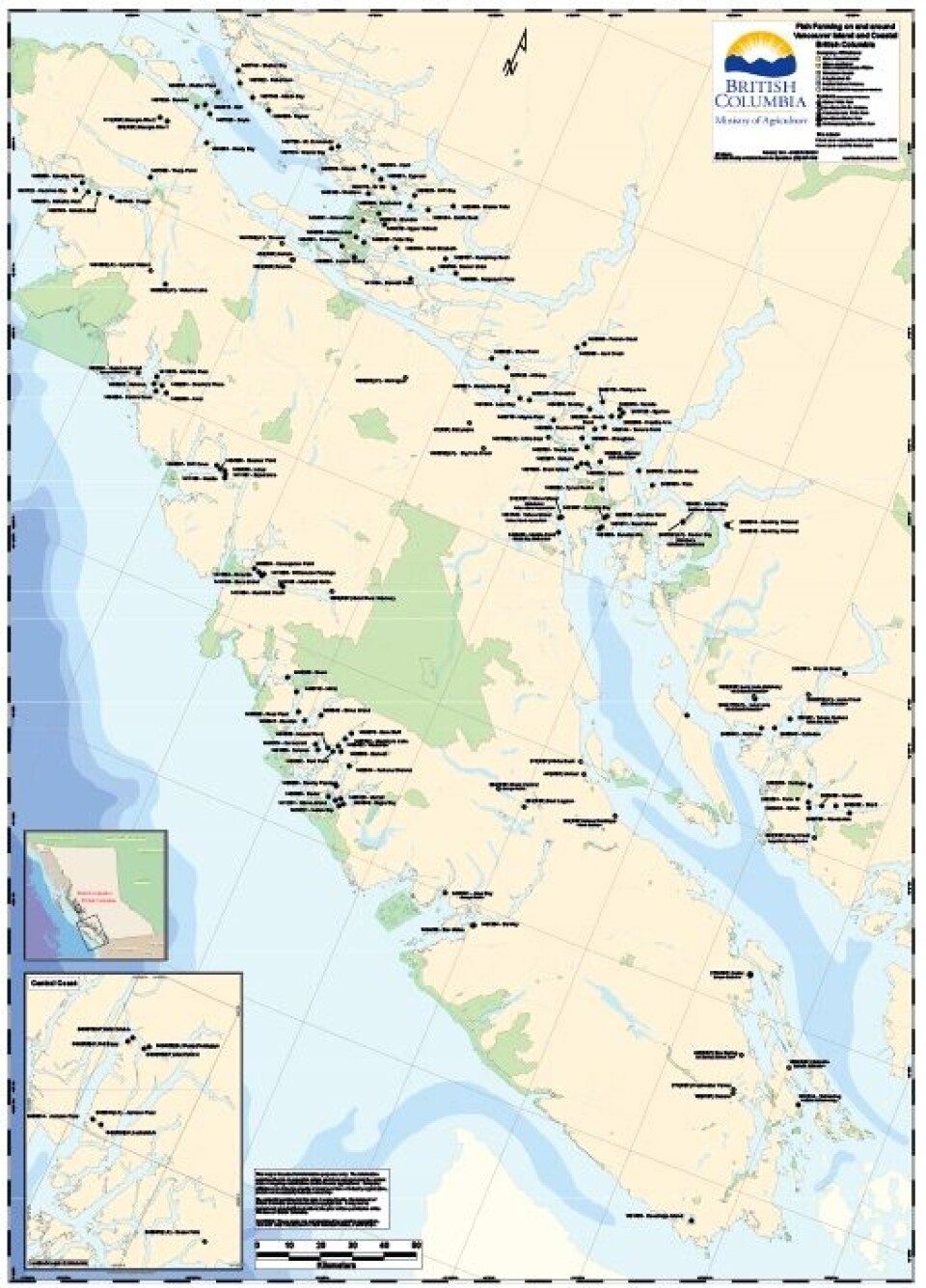
The market distribution of Atlantic salmon saw the~8.4% increase in production during Q2 2013 compared with the same period in 2012 divided by countries/regions as follows;
Country/Region EU USA Russia Japan China/HK Brazil Others Increase, % 5.9% 11.2% 4.6% -4.1% 7.1% 38.8% 11.5%
Mainstream Canada Mainstream Canada reported a second quarter of 2013 with good biological performance, but with higher production costs (8 per cent over that during Q2 2012 and 7 per cent higher than the costs during the first quarter of this year) said to be due to biomass regulations and algae blooms last year. The NOK 54 million (~€6.7 million) EBIT reported for the second quarter of 2013 did not include a biomass write-down of NOK 26.6 million (~€3.32 million, CAD$ 4.55 million) due to an IHN diagnosis and subsequent fish destruction at one of its farms last year. The quarter’s EBIT per kg harvested was close to that achieved by Marine Harvest in British Columbia (NOK 13.40- ~ €1.67 per kg), compared with NOK 2.30 (~€0.29) per kilo for the same quarter a year ago, and the main reason for the improved result being due to higher prices. The company harvested a total of 4,000 tonnes during Q2 2013- down by about 15% from the same quarter a year ago- mainly due to the lack of available fish from its Dixon site that was depopulated last year due to IHN. The quarterly volume expected to be harvested during the remainder of 2013 is expected to remain about the same as Q2- between 3 and 5 thousand tonnes. World-wide, Mainstream expects to harvest about 145,000 tonnes of salmon and trout- an increase of some 25,000 tonnes, mainly due to the anticipated 20,000 tonnes growth in harvest of Atlantic salmon from its farms in Chile. The company remains third in farmed salmon production behind Marine Harvest and the Lerøy Seafood Group, and its parent company Cermaq expects to be flush with cash after completing the sale of its feed division EWOS later this year (October), as well as shares owned in fish-oil maker Copeinca and the industrial food maker Denofa. Some of the cash will be distributed to shareholders, and some will likely be used to obtain some of the 45 new salmon farming consessions proclaimed to be issued by the Norwegian government this fall. Each will reportedly have a price tag of NOK 10 million (~€1.25 million, US$ 1.64 million). Cermaq’s share price on the Oslo stock exchange is up by about 27 per cent to date this year (first week of September).
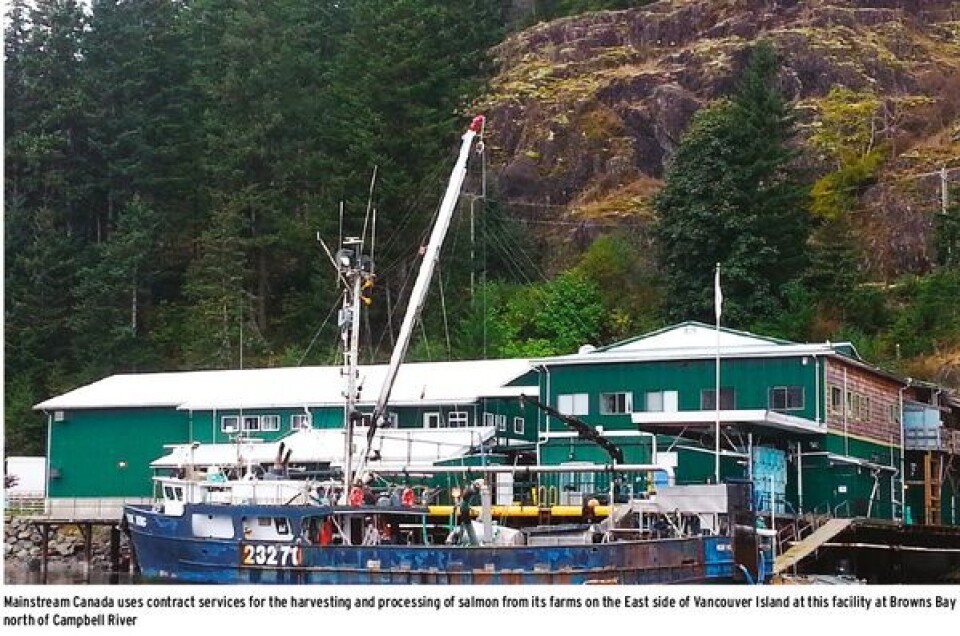
Mainstream Canada reports an average selling price of CAD 7.96 (NOK 46.50, ~ €5.80) per kilo during the second quarter of 2013, which is up by some 45 per cent over that obtained a year ago, and 35% higher than the price during the first quarter of this year. The equivalent prices in US$ per pound (still the main currency in which Canadian farmed salmon is sold) were 3.51, 2.47 and 2.69 for second quarter 2013, same quarter 2012 and first quarter 2013. The company owns 27 farm sites in B.C.- most of them on the west coast of Vancouver near the town of Tofino, as well as between the northern section of Vancouver Island and the B.C. mainland. Mainstream Canada has three main hatcheries/smolt production facilities- all on Vancouver Island- and a processing plant in Tofino. The company also uses contract services for the harvesting and processing of fish produced at its farms on the east side of Vancouver Island- this takes place at Browns Bay just north of Campbell River.
Mainstream Canada is also pursuing the certification of its salmon farms under the GAA BAP program, claiming in 2011 that it was the first company in the World to have one of its farms (Brent Island) certified under this program.
Grieg Seafood BC Grieg Seafood’s production problems due to outbreaks of furunculosis in its hatchery and brood stock holding facility in Gold River on the west coast of Vancouver Island continued in 2012. While the company reports that according to previously reported plans, “comprehensive measures have been implemented at the smolt facility, and this will reduce future biological risk”, the lack of smolts has resulted in low harvest volumes for both 2013 and next year. Grieg Seafood expects to be back to a 15,000 tonne production level in B.C. by 2015.
Harvested volume during the second quarter this year was only 1,107 tonnes, down from the 3,389 tonnes produced during the same period last year. But while the production was down to a third of the previous year’s quarter, revenues were still over NOK 74 million (~€9.2 million) compared with NOK 123 million (~€15.3 million) during Q2 2012. For the first six months of 2013, Grieg Seafood harvested just over 3,000 tonnes from its 21 farm sites in British Columbia, while the volume for the corresponding period in 2012 was about 7,300 tonnes. Overall, Grieg Seafood’s total production of farmed salmon from Norway, Shetland and Canada is expected to be about 64,000 tonnes this year, down some 9% from 2012. The company claims to be well positioned to obtain some of the new licenses announced for the Finnmark region in Norway, where the company already owns 24 licenses. Its overall net profit for the first half of 2013 was NOK 163.6 million (~€20.4 million) on revenues of NOK 1.068 billion (~€133.1 million), and after paying an estimated NOK 69.2 million (~€8.63 million) in taxes.
In British Columbia, Grieg Seafood owns a small processing facility in Egmont on the Sunshine Coast north of Vancouver, but most of its production is processed at the third party-owned Walcan Seafood plant on Quadra Island outside Campbell River. Sales are channelled through a Vancouver-based broker, and Grieg Seafood has been successful in the development and promotion of a premium concept product, marketed under the Skuna Bay Salmon brand.
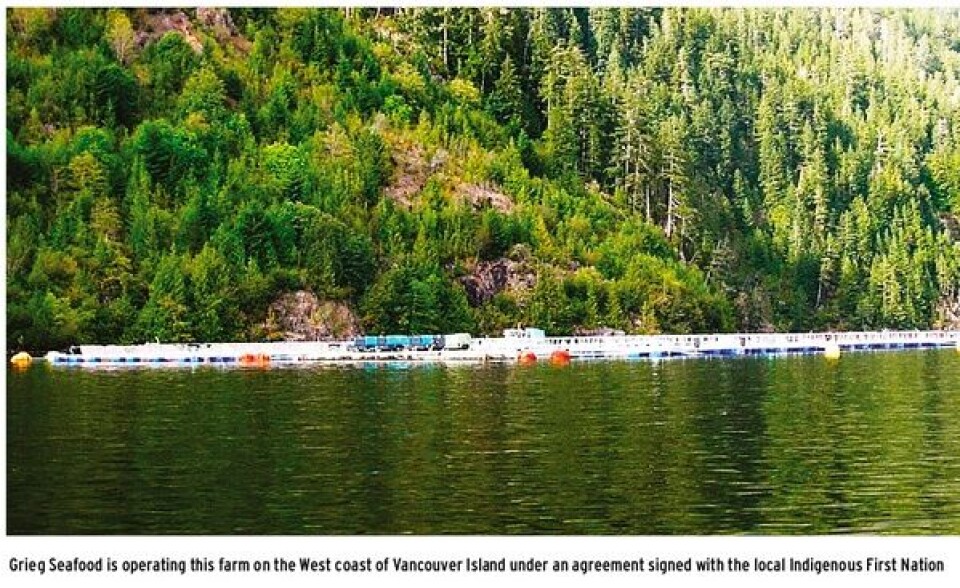
Businesses on Canada’s East Coast The Atlantic Coast Fish Farmers Association (ACCFA) lists among its members three of the largest producers of Atlantic salmon on the east coast of Canada-from New Brunswick in the south to Newfoundland in the north. The largest firm is Cooke Aquaculture which has over 2,200 employees, with salmon farms in Canada, the State of Maine in the United States and in Chile. Cooke also has investments in the production of sea bream and sea bass in Spain. It is difficult to find information about the financial situation surrounding the private aquaculture companies on Canada’s east coast, but here are some points:
Cooke Aquaculture • Cooke Aquaculture is the largest aquaculture company in Canada, with sales of farmed fish for approx. CAD $ 570 million (~ €408 million) each year (December 2012) • Cooke started its salmon farming business in New Brunswick, Canada, but has since established branches in both Newfoundland and Nova Scotia • Cooke’s subsidiary in Chile (Salmones Cupquelan) recently gave a bid to buy two other Chilean salmon farming companies (Acuinova and Nova Austral) for a price between U.S. $300 and 400 million (€221-295 million), which would increase its production capacity by approximately 50,000 tons per year • In Spain, Cooke’s subsidiary Culmarex has acknowledged that it has signed an agreement to acquire Marem Acuigroup-a company involved in the production of the same species as Cooke already breeds and sells from there
Gray Aquaculture • Gray Aquaculture was originally only a smolt producer with facilities in New Brunswick, but as its customers began to establish their own hatcheries, the owners decided that they would start their own fish farming operations • Gray has approval for a number of licenses (Consessions) for farmed Atlantic salmon in Newfoundland • Over the past year and a half, the ISA virus was detected in fish from three of Gray’s farms in Newfoundland, and the company was required to forcibly kill over a million fish • With a debt of approximately CAD $40 million (~ €29 million ), Gray Aquaculture issued a declaration of bankruptcy in August this year and it is now in negotiations with its creditors
Northern Harvest Sea Farms • The company was established in 1985 and has over 250 employees • Northern Harvest has offices in both New Brunswick and Newfoundland and it is headquartered in Letang , New Brunswick
Admiral Fish Farms • The company has several salmon farms along the coast of Grand Manan Island, located on the border between the United States and Canada • Admiral is apparently not a member of ACCFA
All fish farming companies on Canada ‘s east coast enjoy a climate of great interest and financial support from any level of government- both local, provincial and national.
